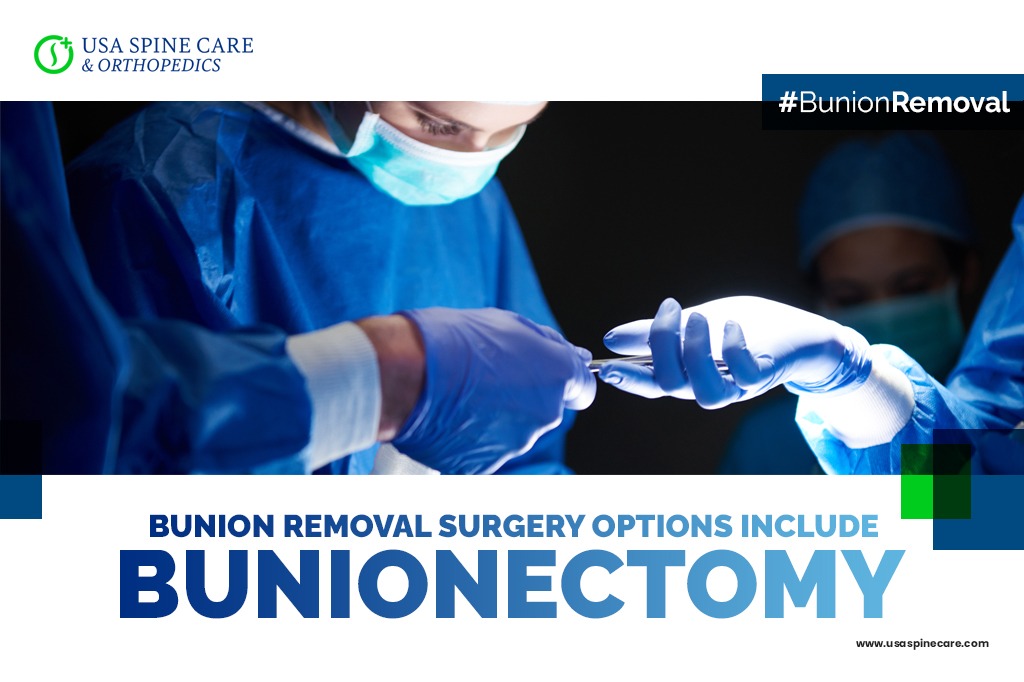- Conditions
- Procedures
- Patient care
- Why choose us
- Our Doctors
- Contact
Bunion Removal Surgery Options Include Bunionectomy

Bunions, also known as hallux valgus, are growths or enlargements of the toe bones that form at the joints, producing a visible protrusion. They can form at the base of the big toes, and less frequently at the base of the little toes.
The primary cause of bunions is prolonged stress on the joints, which is often associated with wearing poorly fitting shoes. This includes shoes that are narrow in the toes, such as many types of high heels. Because of this, bunions more commonly develop in women. However there are other risk factors, including genetics and arthritis, that can lead to their development.
Bunions can very often be treated with non-surgical means, and may not even be painful. However, in cases of severe foot and ankle pain, a surgical procedure known as bunionectomy may be recommended for relieving pain.
To help you learn more about the treatment options for bunions, up to and including surgery, our team is happy to share the following guide. If you would like to learn more, or if there are any questions, we encourage you to reach out at any time.
When to consider bunion surgery
Upon diagnosis of a bunion, the first step will usually be for doctors to recommend changing footwear. In many cases, wearing better-fitting footwear can be effective in relieving pain in the foot and ankle. Patients can also benefit from using orthotics or splints that promote realignment of the toe, particularly in mild and/or recently formed bunions.
If the bunion is causing severe pain and swelling, particularly if it is associated with arthritis, doctors may also recommend taking an over-the-counter medication such as nonsteroidal anti-inflammatory drugs (NSAIDs).
Bunionectomy surgery is an elective procedure and is not cosmetic surgery. The goal is to relieve pain and improve the alignment of the toe bones.
Determining the best approach to bunionectomy
If you are considering bunionectomy, you should expect to undergo a full evaluation from a surgeon to determine the right type of procedure for you. Factors that affect the type of bunionectomy you undergo include:
- The size and severity of the bunion
- Your age
- The presence of other medical conditions
- The health of surrounding soft tissue, including tendons and ligaments
For example, severe bunions often require a bunionectomy where a large portion of the bone is removed. Next, the surgeon will realign the toe and reposition soft tissue. In contrast, less severe bunions may only need removal of the enlarged portion without cutting and realigning the bone.
Surgeons may also use different techniques as well. Many orthopedic surgeons can use a less invasive approach compared to traditional bunionectomy, involving a smaller incision and less disruption of soft tissue. Talk to any prospective surgeon about the best approach for you and your recovery needs.
Bunionectomy recovery
After the procedure, patients will be stabilized in the recovery area, and members of the surgical team will check that all vital signs are normal. From there, patients can expect to receive postoperative and recovery information. This includes caring for the surgical site, and using any footwear or other equipment provided.
Physical therapy and rehabilitation will usually be recommended to help regain strength and range of motion in the foot. Special exercises that involve stretching bands and even marbles can be particularly effective during recovery for toe surgery such as bunionectomy.
It is very important to follow any instructions regarding footwear. Once you are cleared to resume wearing shoes, wearing comfortable and well-fitting footwear helps to ensure that the toe can heal and function properly. In many cases, patients will be strongly advised not wear narrow-fitting fashion shoes after the procedure.
Learn more about bunion treatment at USA Spine Care today
At USA Spine Care, our multidisciplinary team can help you learn more about your treatment options if you are dealing with foot and ankle pain related to a bunion. From physical therapy to bunionectomy, we can help you create a personalized treatment plan that is right for your needs and lifestyle.
To learn more, contact us today.
Bunionectomy Quick Answers
Can I get my bunion removed?
Bunion removal is possible, but only through surgery such as bunionectomy. There are several approaches to this type of surgery, but the overall goal is to remove the portion of bone in the toe that is causing the bunion, and then realign the bones. Bunionectomy is generally seen as a last resort for patients with severe bunion pain.
How painful is a bunionectomy?
A bunionectomy will be performed under anesthesia, so there should not be any pain during the procedure. As with most types of surgery, there is typically soreness and some pain in the surgical area afterward. Your surgical provider will give you detailed instructions for staying comfortable after the procedure, including using elevation, ice packs, and medication as needed.
How long is the recovery for bunion surgery?
Depending on the specific procedure and patient’s state of health, the recovery time varies on a case-by-case basis. Patients will generally be advised to avoid driving in the first week or longer after the surgery and may require a brace or special shoe for one to two months. It is critical to follow all recovery guidelines and to not wear any footwear such as high heels or resume strenuous activities until released by the doctor.
Do bunions grow back?
Most patients will not experience recurrence of the bunion after bunionectomy, but it can occur for some patients. Talk to your surgeon about the potential risk factors for bunion recurrence after surgery.
